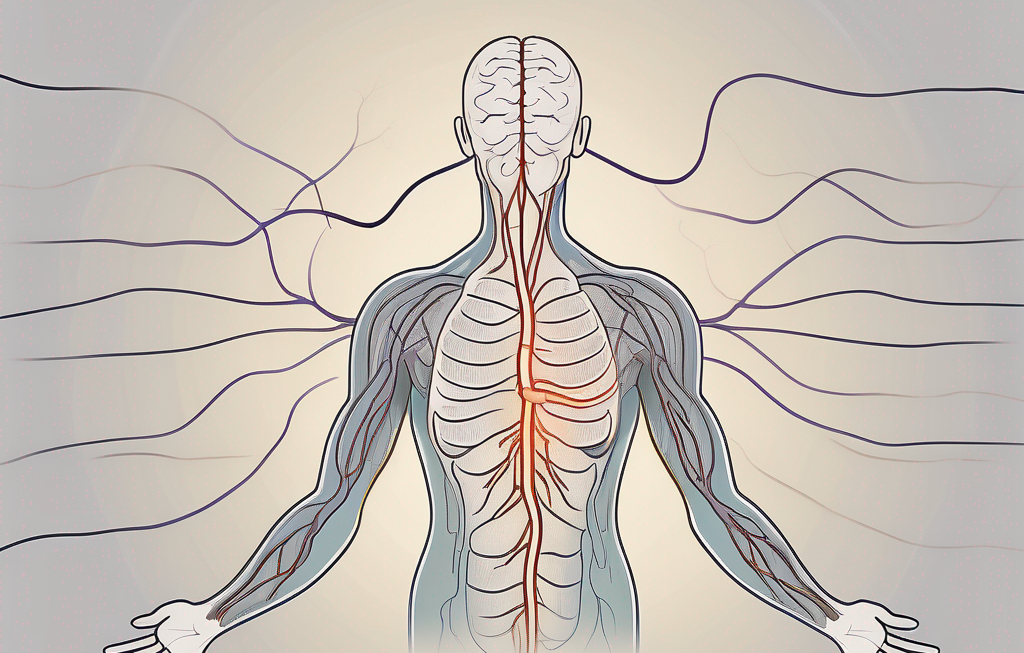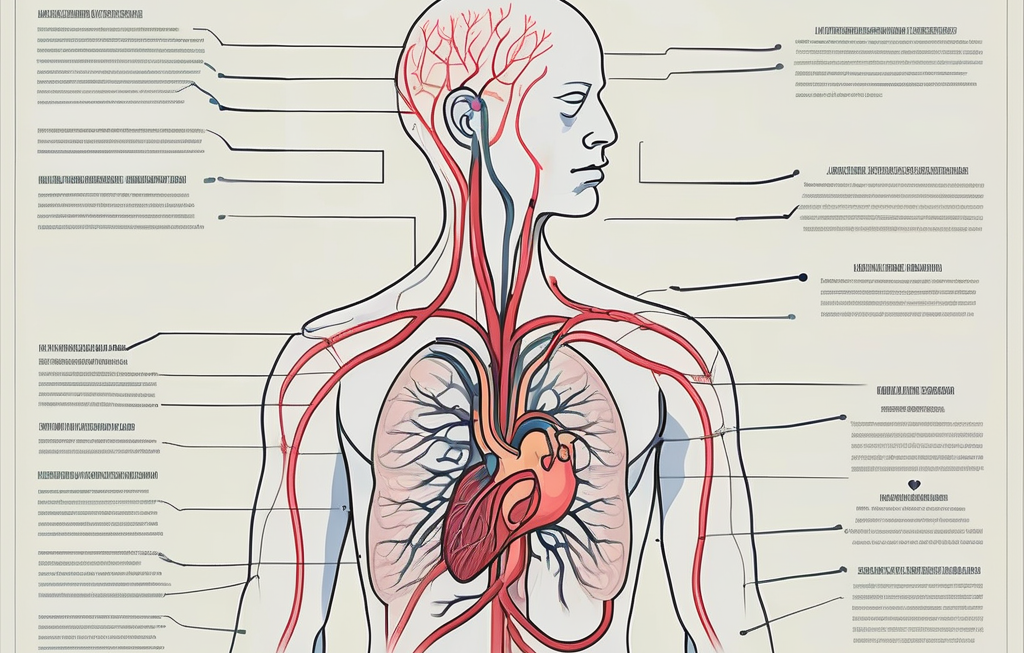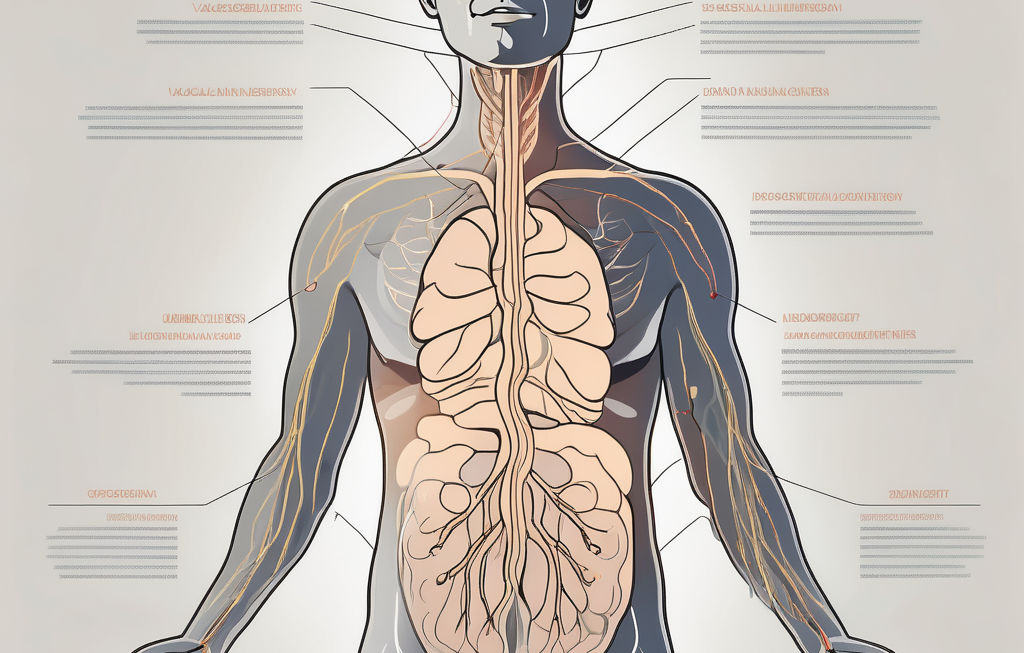The vagus nerve, also known as the cranial nerve X, is a crucial component of the human body. It is an intricate network of sensory and motor fibers that connects the brain to various organs, including the heart, lungs, stomach, and intestines. The vagus nerve plays a vital role in regulating numerous bodily functions, such as digestion, heart rate, breathing, and even the body’s stress response.
Understanding the Vagus Nerve
Before delving into the specifics of how the vagus nerve impacts our health, it is essential to comprehend its role in the human body. By exploring the anatomy and function of this fascinating nerve, we can gain a deeper appreciation for its significance in maintaining overall well-being.
The vagus nerve, also known as the 10th cranial nerve or CN X, is the longest and most complex of the cranial nerves. It plays a crucial role in the parasympathetic nervous system, which is responsible for the body’s rest and digest response. The vagus nerve is like a two-way highway, carrying information to and from the brain and various organs throughout the body.
The Role of the Vagus Nerve in the Body
The vagus nerve acts as a bidirectional communication channel between the brain and various organs. It is responsible for both sending information from these organs to the brain and relaying instructions from the brain to the organs. This intricate connection empowers the vagus nerve to modulate several bodily functions, including heart rate, blood pressure, digestion, immune response, and even emotional state.
One of the most fascinating aspects of the vagus nerve is its role in the gut-brain axis, a complex bidirectional communication system between the gut and the brain. The vagus nerve plays a significant part in this axis, influencing not only digestive processes but also cognitive functions and emotional well-being. This connection highlights the profound impact the vagus nerve can have on both our physical and mental health.
The Anatomy of the Vagus Nerve
The vagus nerve extends from the brainstem down the neck and into the chest and abdomen, branching out to innervate different organs along its path. Its extensive network of fibers spans across the body, ensuring communication and coordination between the central nervous system and peripheral organs. This intricate structure allows the vagus nerve to transmit electrical signals and chemical messengers, known as neurotransmitters, to regulate bodily functions.
Within the brain, the vagus nerve has connections to areas involved in a wide range of functions, including mood, memory, and stress regulation. This intricate network highlights the vagus nerve’s role beyond basic physiological processes, emphasizing its involvement in higher cognitive functions and emotional regulation. Understanding the anatomy of the vagus nerve provides insight into how this remarkable nerve influences not only our physical health but also our mental and emotional well-being.
The Vagal Response Explained
The vagal response refers to the body’s reactions triggered by the activation of the vagus nerve. This response plays a significant role in various physiological and emotional processes, often influencing our overall health and well-being.
The vagus nerve, also known as the 10th cranial nerve, is the longest cranial nerve in the body, extending from the brainstem to the abdomen. It serves as a vital communication highway between the brain and the major organs, including the heart, lungs, and digestive system. The vagal response is a crucial component of the parasympathetic nervous system, responsible for rest and digest functions, in contrast to the fight or flight response of the sympathetic nervous system.
How the Vagal Response Affects Your Body
When the vagus nerve is stimulated, it initiates a cascade of physiological responses that impact numerous bodily systems. These responses include a decrease in heart rate, blood pressure, and stress hormone production. Simultaneously, the vagal response promotes relaxation, digestion, and a sense of calmness throughout the body.
Furthermore, the vagal response is closely linked to our emotional state, influencing our ability to connect with others and experience empathy. Research suggests that individuals with strong vagal tone, indicating efficient vagal nerve function, tend to have better social skills and emotional regulation. This connection highlights the intricate relationship between our physiological and emotional well-being.
The Science Behind the Vagal Response
Neuroscientists have extensively studied the vagus nerve and uncovered the complex mechanisms that underlie the vagal response. The activation of specific neural pathways triggers the release of neurotransmitters, such as acetylcholine, which communicate with various organs and systems. This intricate interplay of signals ultimately leads to the observed physiological and emotional effects of the vagal response.
Moreover, recent research has delved into the therapeutic potential of vagal nerve stimulation for various conditions, including depression, anxiety, and inflammatory disorders. By modulating the vagal response through techniques like deep breathing, meditation, and yoga, individuals can harness the power of this neural pathway to enhance their well-being and resilience.
The Importance of Vagal Tone
Vagal tone, often influenced by genetics, lifestyle, and environmental factors, refers to the overall health and efficiency of the vagus nerve. A strong vagal tone signifies optimal functioning of this crucial nerve, resulting in improved regulation of bodily processes and greater resilience in the face of stress and adversity.
The vagus nerve, also known as the 10th cranial nerve, is the longest of the cranial nerves and plays a vital role in the parasympathetic nervous system. It innervates many organs, including the heart, lungs, and digestive system, and is responsible for regulating various bodily functions, such as heart rate, digestion, and inflammation. A well-functioning vagus nerve is crucial for maintaining homeostasis and overall health.
How to Measure Vagal Tone
Various techniques, including heart rate variability analysis and specific breathing exercises, can provide insights into the health of your vagus nerve. These methods assist in evaluating vagal tone and are often used in research and clinical settings. While these tools are informative, it is important to consult with healthcare professionals for accurate interpretation and guidance.
Another method used to assess vagal tone is the measurement of respiratory sinus arrhythmia (RSA), which reflects the heart rate variability associated with breathing. Higher RSA values indicate a stronger vagal tone and better autonomic nervous system function. Monitoring changes in RSA can offer valuable information about an individual’s physiological resilience and adaptability to stress.
The Impact of Vagal Tone on Health
A robust vagal tone is associated with enhanced physical and mental well-being. It is linked to improved cardiovascular health, immune function, digestion, stress management, and even emotional regulation. Additionally, a high vagal tone can contribute to better quality sleep, cognitive function, and overall resilience to various health challenges.
Research suggests that individuals with higher vagal tone may experience reduced inflammation and lower risk of chronic diseases such as cardiovascular disease, diabetes, and depression. By incorporating strategies to enhance vagal tone, such as mindfulness practices, deep breathing exercises, and social connections, individuals can support their overall health and well-being.
Vagal Stimulation and Its Benefits
Vagal stimulation techniques offer a promising avenue for enhancing vagal tone and promoting overall health and well-being. These methods aim to activate the vagus nerve, triggering the beneficial physiological and emotional responses associated with the vagal response.
The vagus nerve, also known as the 10th cranial nerve, plays a crucial role in regulating various bodily functions, including heart rate, digestion, and inflammation. By stimulating the vagus nerve, individuals may experience improvements in their overall health and resilience to stress.
Techniques for Vagal Stimulation
Deep breathing exercises, yoga, meditation, and mindful practices have all been shown to stimulate the vagus nerve and improve vagal tone. These techniques involve slow, controlled breathing patterns and relaxation exercises, which help activate the parasympathetic nervous system and induce a state of calmness and balance.
In addition to traditional methods, recent technological advancements have led to the development of devices that can provide non-invasive vagal nerve stimulation. These devices deliver targeted electrical impulses to the vagus nerve, offering a convenient way to enhance vagal tone and potentially reap the associated health benefits.
Potential Health Benefits of Vagal Stimulation
While the research on vagal stimulation is still evolving, emerging evidence suggests potential health benefits. These include stress reduction, improved cardiovascular health, enhanced immune function, better digestive health, and even potential benefits for mental health conditions such as anxiety and depression. However, it is important to note that vagal stimulation techniques should be used in conjunction with professional medical advice and not as a substitute for proper healthcare.
Furthermore, studies have indicated that vagal stimulation may also have a positive impact on inflammatory conditions such as rheumatoid arthritis and inflammatory bowel disease. By modulating the body’s inflammatory response, vagal stimulation could potentially offer relief for individuals suffering from chronic inflammatory conditions, highlighting the diverse range of benefits associated with enhancing vagal tone.
Common Disorders Related to the Vagus Nerve
Although the vagus nerve is a vital part of our overall health, it can also be associated with certain disorders and medical conditions. Understanding the symptoms, diagnosis, and treatment options for these conditions can help individuals navigate their health with greater awareness.
Symptoms and Diagnosis of Vagus Nerve Disorders
Disorders related to the vagus nerve can present with a wide range of symptoms. These may include difficulties in swallowing, voice changes, gastrointestinal issues, heart rhythm abnormalities, and even seizures. Accurate diagnosis usually involves a comprehensive evaluation by healthcare professionals, including specialized tests and imaging techniques.
Treatment Options for Vagus Nerve Disorders
The treatment of vagus nerve disorders depends on the underlying condition and may involve various approaches, including medication, lifestyle modifications, and surgical interventions. Seeking appropriate medical care and expert advice is essential for managing these disorders effectively.
In addition to the symptoms and treatment options, it is important to understand the potential causes of vagus nerve disorders. While some disorders may be congenital or genetic, others can be triggered by external factors such as trauma, infections, or autoimmune diseases. Identifying the root cause is crucial in developing a targeted treatment plan that addresses the underlying issue.
Furthermore, it is worth noting that the vagus nerve is not solely responsible for the disorders it is associated with. In many cases, these disorders are multifactorial, involving a complex interplay between the vagus nerve and other physiological systems. For example, gastrointestinal issues related to the vagus nerve may also involve dysfunction in the enteric nervous system or imbalances in gut microbiota.
In summary, the vagus nerve plays a pivotal role in regulating essential bodily functions and maintaining overall health and well-being. Understanding the vagus nerve’s anatomy, the impact of the vagal response, and the importance of vagal tone can provide valuable insights into our bodies’ intricate workings. Exploring techniques for vagal stimulation and becoming aware of common vagus nerve disorders allows us to take a proactive approach to our health, fostering a greater sense of balance and resilience in our everyday lives.



